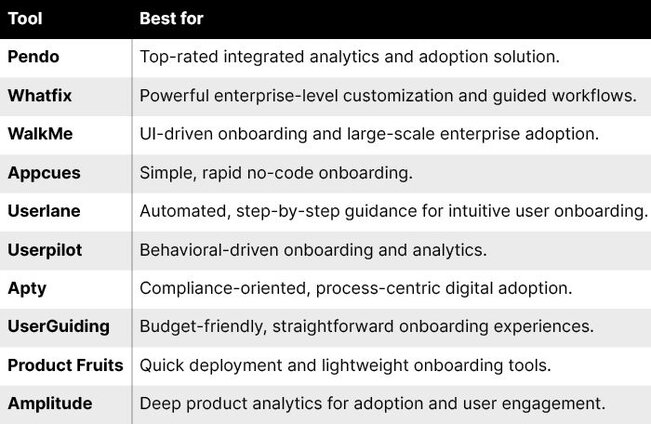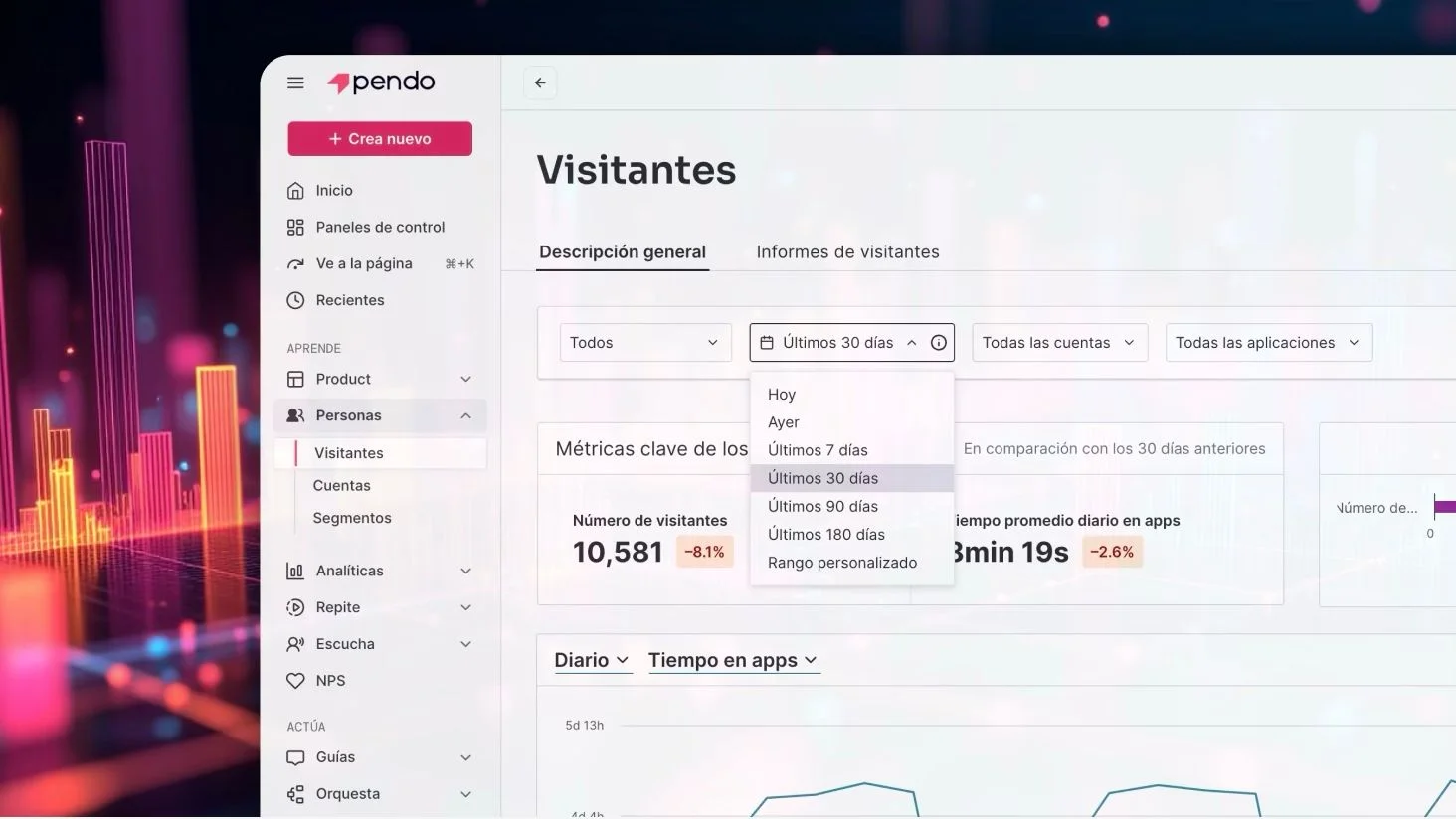Digital adoption platforms (DAPs) are the interface between users and a digital application. These software overlays offer real-time, in-app guidance that help users learn how to use other software applications and, in turn, accelerate proficiency, engagement, and digital adoption.
The right DAPs will significantly optimize your business. They accelerate learning, minimize support tickets, and boost ROI for customers and employees. Simply put, they’re a crucial component for any team using software as a tool for business, whilst looking to improve the end-user experience.
Below, we’ll take you through the leading platforms available in 2025 with in-depth reviews of the top ten DAPs shaping the landscape of user onboarding, training, and support today.
So. Let’s get stuck in.
Key features of a great digital adoption platform
An effective DAP goes far beyond a basic walkthrough. The best-in-class enable different systems to integrate seamlessly with one another. They show a clear understanding of user behaviour, with intelligent guidance that improves the software experience.
Essential DAP capabilities include interactive guidance (such as walkthroughs, tooltips, checklists), contextual help, and robust analytics for user behavioral insights.
To delve a bit further here, a key feature of modern DAPs is the ability for admins to create and manage guidance content quickly, without a need for code. This emphasis on "no-code" is crucial. It empowers non-tech teams to rapidly create and iterate on in-app experiences, whilst staying agile and responsive.
The convergence of analytics and action within one platform is also critical, and this is where Pendo excels. It combines advanced analytics with the ability to act on insights. This, in turn, provides a closed-loop system for continuous improvement.
Pendo brings everything together in one place: product analytics, in-app guidance, feedback, session replay. Its holistic approach eliminates tool sprawl, unifies data and enables proactive in-app interventions. And this is what sets it apart as a Software Experience Management (SXM) platform.
The top 10 DAPs at a glance

Let’s take a closer look at the top DAPs
1. Pendo – Integrated analytics & adoption leader
Pendo is the leading SXM platform. It unifies product analytics, in-app guidance, feedback, and session replay to optimize the entire software experience.
Key features & strengths: Unmatched analytics capabilities, with deep insights into user behavior, retroactive tracking seamless user guidance integration.
Ideal use cases: Mid-market to enterprise SaaS companies, focused on product-led growth; Product teams unifying analytics, guidance, and feedback; Organizations improving customer experience, employee productivity, and digital transformation.
Pendo’s holistic approach to integrate both analytics and adoption is what gives the platform its unrivaled edge.
2. Whatfix – Enterprise customization
Whatfix maximizes software value through engaging walkthroughs and self-help support for both customer-facing and internal applications.
Key features & strengths: Strong customization and complex workflow capabilities. Extensive in-app guidance (product tours, flows, checklists, tooltips, self-help wikis).
Ideal use cases: Large enterprises that need extensive customization and guided experiences for customer-facing and internal applications.
Comparison to Pendo: Does not offer the same depth of analytics and deep integration of qualitative feedback as Pendo.
3. WalkMe – Large-scale enterprise adoption
WalkMe offers a comprehensive platform for large-scale enterprise adoption and employee training, and leverages AI-powered automation.
Key features & strengths: Strong scalability across various applications (SAP, Salesforce, Workday) and UI intelligence.
Ideal use cases: Large enterprises focused on employee onboarding and training across complex, customized internal applications.
Comparison to Pendo: Effective at large scales but less robust analytics than Pendo. Comes with complex implementations that often require a third party. Demands a steep learning curve.
4. Appcues – Quick no-code onboarding
Appcues is a no-code user onboarding tool designed for simplicity and speed. It enables rapid creation and deployment of product tours and user guidance.
Key features & strengths: Simplicity, speed of implementation and a slick UI. No-code editor to build flows and track events.
Ideal use cases: Teams seeking a quick, no-fuss onboarding tool. Startups and small businesses looking for a budget-friendly, easy-to-deploy solution.
Comparison to Pendo: Appcues excels in simplicity and onboarding speed. But Pendo provides significantly more comprehensive and advanced analytics. Plus, it offers a more robust mobile onboarding, with advanced customization at lower tiers.
5. Userlane – Automated step-by-step guidance
Userlane offers intuitive, automated, step-by-step guidance directly within software applications. It prioritizes real-time learning as you work.
Key features & strengths: Strong focus on automated guided walkthroughs. Ease of use and setup. Simpler to deploy than complex enterprise solutions.
Ideal use cases: Teams that need to scale onboarding and support without increasing staff.
Comparison to Pendo: Effective for straightforward guidance but ultimately, lacks Pendo’s comprehensive analytics connecting qualitative insights back to user behavior.
6. Userpilot – Behavior-driven product onboarding
Userpilot is a no-code digital adoption platform offering a streamlined, user-friendly experience. It focuses on behavior-driven onboarding and in-depth product analytics.
Key features & strengths: Behavior-driven onboarding triggered by user actions or segments. Its product analytics support autocapture of events and visual reports (such as Paths, Funnels, Retention).
Ideal use cases: Product-led teams seeking no-code onboarding, feature adoption, and contextual guidance.
Comparison to Pendo: Solid onboarding but far less comprehensive analytics versus Pendo. Pendo’s strong focus is on product planning and roadmapping tools (Pendo Feedback, Listen) and is more suitable for employee onboarding third-party applications.
7. Apty – Process and compliance adoption
Apty is a digital adoption platform for enterprises. It prioritizes real business outcomes, and specializes in operational guidance, compliance and workflow adoption.
Key features & strengths: Focuses on business process optimization and measurable outcomes. Ideal for compliance-heavy industries.
Ideal use cases: Compliance-heavy industries that need to enforce process adherence. Enterprises with complex and frequently changing software environments.
Comparison to Pendo: Specialized adoption strengths but lacks Pendo’s comprehensive analytics and cross-channel engagement orchestration.
8. UserGuiding – Simple and affordable onboarding
UserGuiding is a no-code product adoption platform. It focuses on aiding adoption through powerful in-app elements and offers a straightforward, budget-friendly solution.
Key features & strengths: Ease of use and setup with an intuitive UI. Ideal for startups and small businesses.
Ideal use cases: Startups and small businesses seeking a cost-effective yet comprehensive onboarding solution.
Comparison to Pendo: Cost-effective but limited compared to Pendo’s robust features; these include website features, funnel analysis, and roadmapping.
9. Product Fruits – Rapid onboarding deployment
Product Fruits is a user onboarding and retention tool that provides essential in-app engagement and guidance features. It’s known for its quick deployment and minimal learning curve.
Key features & strengths: Speed of implementation and ease-of-use. Essential in-app engagement features (tours, guides, hints, checklists, announcements).
Ideal use cases: SaaS and software companies needing rapid user onboarding and new feature introduction.
Comparison to Pendo: Great for a rapid setup. Ultimately, offers limited advanced analytics compared to Pendo and lacks advanced impact reports or goal tracking.
10. Amplitude – Product analytics for digital adoption
Amplitude is an advanced analytics platform. It emphasizes deep user engagement insights, and seamless session replay integration.
Key features & strengths: Deep analytics capabilities for detailed product insight. Experimentation module for multivariate testing to validate hypotheses.
Ideal use cases: Consumer facing brands with growing data and advanced analytics requirements. Teams focused on data-driven strategy and experimentation to boost conversion and lifetime value.
Comparison to Pendo: Outstanding analytics but lacks qualitative collection and analysis capabilities - core features of Pendo's platform. Crucial to help businesses drive product innovation and impact.
What sets Pendo apart
Pendo is the only complete product platform to combine product analytics, targeted in-app guides, and comprehensive feedback collection into a single SXM platform. This integrated approach effectively streamlines your toolkit, centralizes data, and reduces digital friction. And it enables diverse teams to work together more seamlessly and efficiently, too.
Pendo holds a clear advantage in multiple areas beyond this. It offers an unmatched ability to track user behavior and implement targeted adoption, instantly. Its product analytics provide deep understanding of user interactions powered by trillions of data points. And its AI and automation capabilities offer instant recommendations and personalized in-app guidance - so you can quickly turn insights into action and grow your product faster.
Pendo’s depth of analytics and seamless integration will work for businesses of any size. From startups to large enterprises, its ease of scalability makes it the smart choice for long-term.
Choosing the right DAP for you and your team
The best platform for your product depends on your business stage and size, the depth of the analytics you need, the complexity of user onboarding, as well as industry-specific needs.
There are multiple components to factor in here. Pendo considers all of these and offers a solution that, importantly, works for both customers and employees. So while specialized DAPs undoubtedly have their strengths, none of them offer that full-spectrum approach in quite the same way as Pendo.
Top tips to successfully implement a DAP
To really leverage the power of your DAP a strategic approach is essential.
- Define measurable goals for adoption, engagement, and productivity. These will serve as benchmarks to evaluate the DAP's performance and demonstrate its ROI
- Ensure seamless integration within existing workflows. Consider how the DAP interacts with your current software ecosystem. Its effectiveness is enhanced significantly when it operates as an integral part of your users' daily routines, not just as an add-on.
- Train internal teams on how to interpret analytics for ongoing improvement. The true power of a DAP lies in its ability to guide users as well as in the rich insights it provides. Invest in your teams to unlock this in full. Provide thorough training to help them learn how to interpret and act upon these data points.
- Review, refine and iterate adoption strategies as you go. Digital adoption is an ongoing process of continuous improvement. Regularly review what’s working, and what’s not, to ensure sustained success in the long-term.
Why Pendo takes the edge
When it comes to the competition, Pendo’s differentiating edge is its ability to consolidate analytics, guidance, and feedback into one SXM platform. It eliminates tool sprawl and provides a single source of truth. It’s clean, it’s clear and it’s simple.
The best DAPs will maximize software ROI and enhance your user experience. Pendo goes one step further to elevate your software experience and offer a 360 approach to solving complex problems, across multidisciplinary teams, with both clarity and ease.
See for yourself how. Schedule a live demo today.
![[object Object]](https://cdn.builder.io/api/v1/image/assets%2F6a96e08774184353b3aa88032e406411%2F8472924f687a4c359fb61b69d3ac4ea4?format=webp)



